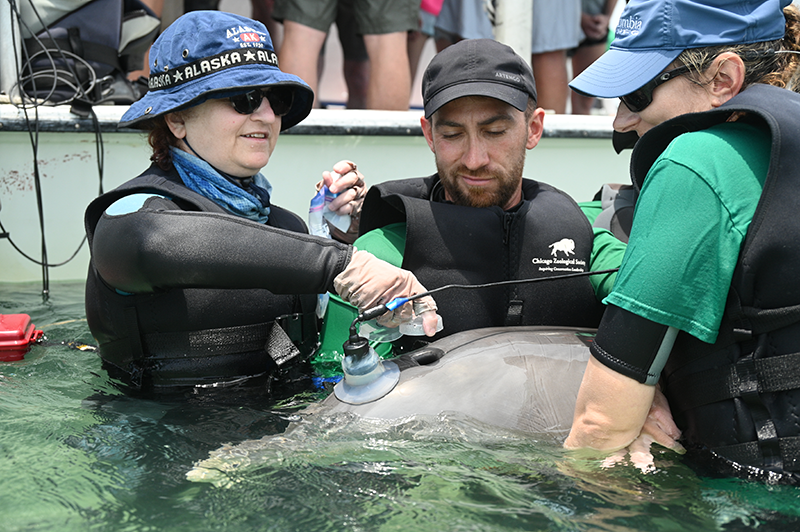Every Breath They Take? New Study Suggests Dolphins are Inhaling Plastics

A member of the SDRP research team holds a petri dish over a dolphin’s blowhole to collect a breath sample during a health assessment.
In a first-of-its-kind study, researchers have detected microplastic particles in the exhaled breath of wild bottlenose dolphins, highlighting inhalation as a potential route of exposure to these harmful contaminants, according to the new research paper “First evidence of microplastic inhalation among free-ranging small cetaceans” published in the peer-reviewed journal PLOS One. The research study’s lead authors were Miranda Dziobak and Leslie Hart from The College of Charleston and University of South Carolina, with co-authors from the Sarasota Dolphin Research Program, Fundación Oceanogràfic (Valencia, Spain), the National Marine Mammal Foundation, Virginia Tech and The Citadel.
For the study, the researchers collected breath samples from dolphins in Sarasota Bay, Florida, and Barataria Bay, Louisiana, that revealed the presence of various microplastics, including fibers and fragments. This research suggests that dolphins, like humans, may be vulnerable to microplastic inhalation, raising concerns about potential health impacts such as lung damage.
While previous studies of bottlenose dolphins (Tursiops truncatus) have reported prevalent exposure to plasticizing chemicals (e.g., phthalates) as well as particle loads in gastrointestinal tracts, this was the first time that exposure from inhalation had been studied. Authors gathered exhalation samples from five dolphins in Sarasota Bay and six in Barataria Bay during catch-and-release health assessments to screen for microplastic particles. All dolphin samples contained at least one suspected microplastic particle, and polymer composition was determined for 100% of a subset (17) of samples.
Given significant gaps in knowledge regarding the health effects posed by inhaled particles, implications for these findings are unknown, the authors wrote; however, laboratory rodent and human epidemiological studies suggest lung damage could result from this type of exposure and that vulnerable populations — like the dolphin community in Barataria Bay that is still suffering the impacts of the Deepwater Horizon oil spill — could be more at risk. Further research to understand health implications following inhaled microplastic exposure is warranted, especially among vulnerable populations experiencing adverse pulmonary impacts.
Citation
Dziobak MK, Fahlman A, Wells RS, Takeshita R, Smith C, Gray A, Weinstein J, Hart L. (2024) First evidence of microplastic inhalation among free-ranging small cetaceans. PLOS ONE 19(10): e0309377. https://doi.org/10.1371/journal.pone.0309377
News Links
New York Times: These Scientists Tested Dolphin Breath. They Found Plastic.
The Guardian: Microplastics found in dolphin breath for first time – study
CNN: Wild dolphins off US Southeast coast found with microplastics in their breath, study says
BBC Discover Wildlife: Scientists just collected 11 petri dishes of dolphin breath – and found something very worrying
The Independent: Dolphins are inhaling microplastics just like humans, study finds
New Scientist: Dolphins breathe in microplastics and it could be damaging their lungs
SciTechDaily: Disturbing Discovery: Dolphins Breathe Out Microplastics
The Conversation: Microplastic pollution is everywhere, even in the exhaled breath of dolphins – new research
Wired: Dolphins Are Exhaling Microplastics
IFLScince: Microplastics Detected in Wild Dolphin Breath For The First Time




